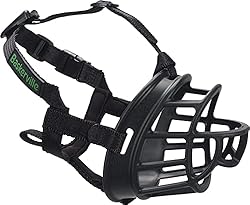
As the owner of a formerly reactive dog, and a dog trainer who has worked with hundreds of dogs on this issue, the one thing I can confidently say about dog training for reactive dogs is there is no one-size-fits-all solution.
But don't let that frustrate you! I've collected 6 of the most common mistakes, tips and ideas for trouble shooting and solving the puzzle of your reactive dog.

Dog Training for Reactive Dogs
This article is not meant to replace professional training advice. Since reactivity is a complex topic, it is best to consult with a professional trainer with experience in reactivity or a dog behaviorist.
This post is meant to help you learn about your dog and start implementing small things that could lead to an even bigger result.
Related: Dog Training Essentials | 17 Tools to Improve Your Dog's Behavior
Best Dog Training for Reactive Dogs
1. Set up a communication system
When it comes to reactivity, one of the most important things to have with your dog is a communication system. Otherwise, how will you tell them that they're doing the right thing or the wrong thing?
Think of the game hotter and colder you play with kids. You had to explain the rules to the kid before you played. The word "warmer" meant that the player was getting closer to the hidden object. And saying the word "colder" meant the player was moving further from the object. Without the system, the game would be called closer/further.
In order for the game to feel fair, you had to set up your communication system so the player had a chance at winning.
Related: How to Get Your Dog to Focus on You Outside
So, setting up a clear system in low distraction environments with your dog is an essential part of being fair and helping your dog understand what you want.
Typically, most trainers utilize using the words "yes " and "no" to help your dog understand a reward or correction is coming.
"Yes" would mean "you did the right thing, a treat or other reward is coming."
And "no"= no, that's not right, fix it, or a correction is coming. Use this game to set up your "yes" system!
Why is my dog suddenly reactive to other dogs
2. Follow through on communication system
Now that you have a communication system set up, you'll need to make sure your dog understands that the communication system is important.
Let's look at the system again:
"Yes" would mean "you did the right thing, a reward is coming."
And "no"= no, that's not right, fix it, or a correction is coming.
That second half is soooo important.
Your dog is always experimenting with how much they have to listen to you versus how much they can do what is the most fun (or most important). Your dog may feel that reacting, barking, and lunging is the most fun or most important. And you need to teach them that the communication system is the most important.
"Yes" or "no" without a follow up just goes in one ear and out the other for a dog.
When training your dog, make sure you have a way to follow through on what you've asked. If you ask something of your dog that you can't follow through on, they will learn that what you say is more like white noise than instructions.
Following through means using your space, a leash or a treat in order to show the dog what you've asked of them.
How to calm a reactive dog
3. Train relaxation
When reactivity seems to come on suddenly, it's usually due to a dog's lack of confidence.
What's likely happening is that your dog's confidence has been decreasing, and the reactivity indicates that they've finally found a way to tell you, "I'm uncomfortable, I'd like to leave" in a way that you actually listen.
Consider this, while on a walk, your dog may have been showing other behaviors to convey that they were uncomfortable. For example, they may have been trying to move away, jumping up on you, sniff the ground or pulling on the leash to indicate their discomfort.
But, if you were not paying attention to those more subtle cues from your dog, you likely ignored them, and the dog didn't feel like they were being listened to. Or perhaps you even scolded your dog for trying to leave, jumping up or pulling away.
Related: Loose Leash Dog Training in 4 Simple Steps
One day, your dog tries barking and/or lunging- and boy does that one work! We quickly move them from the situation and the dogs remembers, "If I bark and lunge when I'm uncomfortable, then my owner will take me further away from the scary thing"
If this is the case for your dog, conditioning relaxation and socialization is going to be a huge key to success for you and your dog.
Dog Training for Reactive Dogs Near Me
4. Pay attention to your dog
It is much easier to redirect your dog when they first notice the thing they are reactive about, rather than waiting until they are barking and lunging.
Some owners ask, "what do I do when my dog is barking/lunging?"
The answer: How did you get to a point where you allowed your dog to lunge?
Pay attention to your dogs center of gravity, their breathing, their ears, their gaze. If they get stiff/tense or are starring at their trigger, don't hesitate to get more distance between you and their trigger ASAP. Changes in their body language will tell you when they're about to react.
Intervene when your dog has a fuse, don't wait for the explosion.
Addressing your dog's concern early is the easiest way to prevent reactivity and stop the reactivity in the moment. A behavior practiced is a behavior learned.
My reactive dog is ruining my life
5. Muzzle train your dog
It is completely normal to feel like your dog's behavior is making your life smaller. When in doubt, consult with a behaviorist or dog trainer who has had success with reactivity.
I often recommend to clients with reactive dogs to muzzle train their dogs. I do this for a few reasons:
1. For you (or whoever is holding the leash) to have peace of mind. With a muzzle, you make your dog's world a little bit bigger.
2. For safety. If nothing else the muzzle gives you time. A muzzle can prevent lawsuits, hospital and vet bills and even euthanasia.
3. For space. For whatever reason, people see a muzzled dog and they keep their distance (even though your muzzled dog is way safer than any unmuzzled dog. And space is what your reactive dog needs.
(P.S. I prefer the Leerburg Dog Muzzle)
How to calm a reactive dog on a walk
6. Don't be afraid to calmly and confidently lead your dog
If your dog starts reacting while you're on a walk, it is important to help him calm down before the other dog leaves. The best way to do this is by leading them confidently. Try circling your dog, changing direction, getting some distance and playing the Focus Game.
Related: How to Use a Slip Leash
However, be very careful not to project your feelings by saying things to your dog like, "It's okay" "You're fine" or to pet your dog in this scenario. Your dog does not need comfort, they need leadership.
We want their calm state of mind to correlate with the "scary thing" going away.







